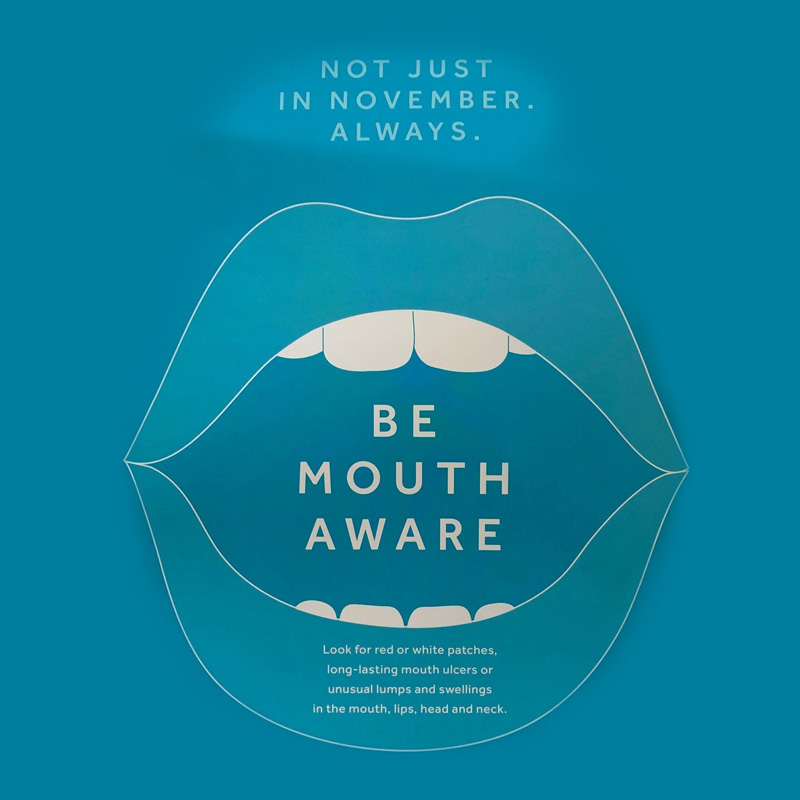

November is Mouth Cancer Action Month. These 30 days are for fundraising and improving our understanding of this dangerous disease.
Last year, 8,864 people received the life-changing news that they have mouth cancer.[i] Able to spread quickly, mouth cancer claims more lives than cervical and testicular cancer combined. It is also a bigger killer per year than road traffic accidents.i Being able to identify the signs and symptoms is essential to save lives – the earlier the diagnosis, the more successful the treatment can be.
Signs and symptoms
Mouth cancer can develop in the tongue, gums, inner cheek lining, floor of the mouth, and lips.[ii] Current awareness of the signs and symptoms of mouth cancer is at 17%.i This must increase to give at-risk patients the best shot at beating it.
There can be many symptoms of mouth cancer. Visual changes may include:
Other symptoms are:
If any of these symptoms persist for more than two weeks, see a doctor or a dentist. Early diagnosis can stop the fast spread of the cancer.
Knowing the risk
Certain people are more likely to develop mouth cancer than others. There are many risk factors that cannot be controlled. These can include age, a family history of mouth cancer, having a weakened immune system, and gender. However, there are some preventable risk factors.
The most well-known risk factor for mouth cancer is smoking – it is linked to over 60% of mouth cancers.[iv] This is because tobacco contains over 60 toxic chemicals that can cause cancer.[v] These are called carcinogens. Smokers who also drink large quantities of alcohol are at an even greater risk.iii Quitting smoking or switching to e-cigarettes can reduce the risk of mouth cancer.
Another preventable risk factor is human papillomavirus (HPV) infection. HPV is one of the most common STIs.[vi] It often goes away on its own but sexually active people should get regular STI tests and practice safe sex. School vaccination programmes have also proven successful.
People who work outside for long periods of time are also at risk. This can include farmers, sailors and builders. The constant exposure to the sun and UV rays can increase the risk of mouth cancer developing. Wearing an SPF lip balm and shielding the face with a hat can reduce this risk for outdoor workers.
Be part of the battle
Incidence of mouth cancer has risen by 49% over the past decade.i Being able to spot signs and symptoms is important for treating it early. At-risk patients need regular check-ups and should control any harmful lifestyle choices that can reduce the risk of mouth cancer.
This November, join us in raising awareness for the symptoms and risks of mouth cancer. From educating family members to encouraging smokers to vape, there are many small ways that you can get involved. Don’t let mouth cancer impact the lives of those around you.


BRACES


BONDING


Dental Health Plan
We are accepting new patients, book an introduction call today
Book An Introduction Call
Reflecting on a year we’re incredibly proud of ✨
From personal milestones to team wins, here’s what 2025 has meant to our Evolve team. Growth, gratitude and plenty of reasons to smile — we can’t wait to see what the next year brings 🤍


✨ Finance made simple ✨
In this video, Julie answers one of our most frequently asked questions: what finance options are available at Evolve?
From spreading the cost of treatment to finding a plan that works for your budget, Julie explains the options clearly and simply – so you can make an informed decision without any pressure.
If you’ve been putting off treatment because of cost, this one’s for you. 💙
📩 Get in touch with reception if you’d like to talk through your options.


Do you need to change your diet during teeth whitening? 🤍
Jessica answers one of our most frequently asked questions, sharing simple, practical advice to help you get the best results from your whitening treatment — without taking the joy out of everyday life.


Ever wondered what it’s really like to have a filling at Evolve? 🤍
Maggie talks through the process step by step — from feeling at ease on arrival to gentle, considered care throughout treatment. It’s all about making your experience as comfortable and reassuring as possible.


Wish everyone a very Merry Christmas.


The cheeky Evolve Elf has been up to tricks this December, you can`t turn your back for a minute before he`s causing mischief.


🐾 Have you spotted our Gromit collection yet? At Evolve Dentistry, we’ve collected all of the Gromit figurines, and they’ve become quite the talking point!
In this video, Carol explains why we we started collecting Gromits back in 2013.
Come see the collection for yourself next time you’re in the area!
#EvolveDentistry #GromitCollection #PortisheadDentist #FunAtThePractice #CommunitySmiles #thegrandappeal





